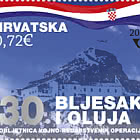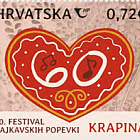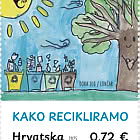Europa - Endangered National Wildlife
EURASIAN LYNX
The Eurasian lynx (Lynx lynx) is the largest European cat. It is one of the most widely distributed cat species, thus it is classified as Least Concerned. In Croatia it can be found in Gorski kotar, Velebit and Lika. According to the latest official estimate from 2010, there are 40 to 60 individuals living in Croatia, with a declining trend, so in our country the lynx is a highly endangered and strictly protected species. The major causes of endangerment are inbreeding, habitat destruction and fragmentation and poaching.
Their hind legs are longer than the front legs. Like all cats, lynx species too can retract their claws when walking. They have excellent night vision, a well-developed sense of smell and extremely good hearing and hunt alone by quietly stalking and pouncing on their prey. During the summer, they have a relatively short, reddish or brown coat interspersed with darker spots unique to each individual. In winter, they get a thick, long and silky greyish fur. During the winter their large paws act like snowshoes in deep snow. They live alone and do not stay for long in the same location except during the mating season, which is at the beginning of the year. Females give birth to two or three cubs. In order to survive, they need a spacious and peaceful, mostly forest habitat, which provides both shelter and food. In Croatia, the most important prey species for lynx are roe deer and young deer, but also chamois, mouflons, rabbits, rodents, birds and snakes. They mostly rest during the day and night and become active in the mornings and evenings.
The autochthonous lynx from Croatia disappeared at the beginning of the 20th century, and the entire present-day population originates from six individuals brought to Slovenia from Slovakia back in 1973. The population began to decline again in the 1990s, and genetics have shown that it is mainly due to inbreeding. Therefore, the LIFE project of introducing lynx from Romania and Slovakia to Croatia and Slovenia is currently underway in order to enrich the gene pool and increase the existing population, as well as to connect the Alpine and Dinaric populations. The inhabited animals and their offspring are tracked using camera traps and GPS collars.
WESTERN CAPERCAILLIE
The Western capercaillie (Tetrao urogallus) is our largest forest bird that originates from the Ice Age. In Croatia, they live on Velebit and in Gorski Kotar, in mixed and coniferous forests on mountain peaks reaching 1000 meters above sea level and higher, where they find shelter on the branches of old trees and an abundance of food. Globally, due to its large range, capercaillies are assessed as being of Least Concern, but their numbers are declining due to climate change, habitat loss and changes in habitat conditions, tourism, collisions of young birds with power lines and too many predators such as foxes, martens, crows as well as poaching. Due to its declining population, the capercaillie is strictly protected in Croatia and is considered an endangered species. Only a dozen out of the former 177 leks in our country are active, and there are just over a hundred singing males. A courtship ground called a lek or an arena is where mating occurs after which they diverge. In the spring, at dawn, the male performs a courtship display at this open space by "singing" (different types of vocalisations - "clicking" and "scraping"), spreading his fanlike tail and extending his “beard”, and becomes careless.
They feed on buds, young pine needles, seeds, forest fruits and berries, and for the young, food of animal origin - insects, snails, and even small vertebrates - is also important. They typically weigh about five kilograms and range up to 85 cm in length. The males have gorgeous feathers: green chest, brown back, and a black head, neck and belly. Capercaillie females have inconspicuous reddish and grey feathers with black stripes. Their legs are feathered all the way to the toes (in winter it is extremely long). Each fall the chainmail-like scales on their feet give way to tiny bristly projections called pectinations that increase each foot’s surface area, making it easier for them to navigate in snow. In summer the pectinations fall off. Strong, blunt nails are used to dig food out of the ground and under snow.
Marijana Vuković M.Sc. and Renata Brezinščak, B.Eng.
Croatia - Recommended stamp issues
WOPA+ recommended stamp issues
| Avatar - Fire and Ash |
| Issued: 03.12.2025 |
| ›New Zealand |
| 50th Anniversary of the Founding of the 24th November Bar Scout |
| Issued: 24.11.2025 |
| ›Montenegro |
| Krisjanis Valdemars |
| Issued: 02.12.2025 |
| ›Latvia |
| Sign Language - Good |
| Issued: 02.12.2025 |
| ›Bosnia and Herzegovina - Republic of Srpska |
| In Memory of the Fallen and Murdered on October 7, 2023 |
| Issued: 08.10.2025 |
| ›Israel |
| Annual Collection Folder (New York) |
| Issued: 05.12.2025 |
| ›United Nations |
| Year Set |
| Issued: 24.11.2025 |
| ›Isle of Man |
| Shipping in the 17th and 18th Centuries - Peat Shipping |
| Issued: 05.12.2025 |
| ›Netherlands |












































